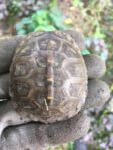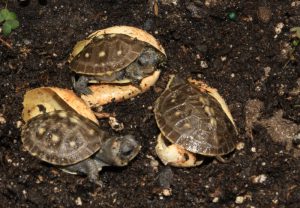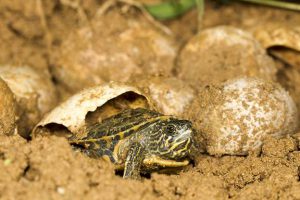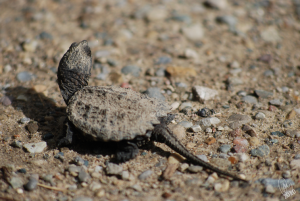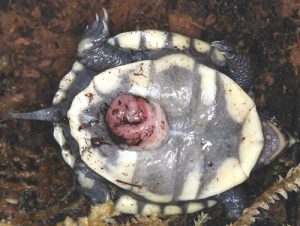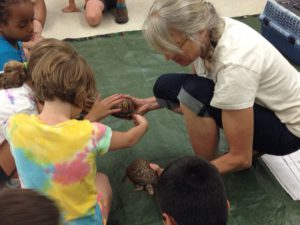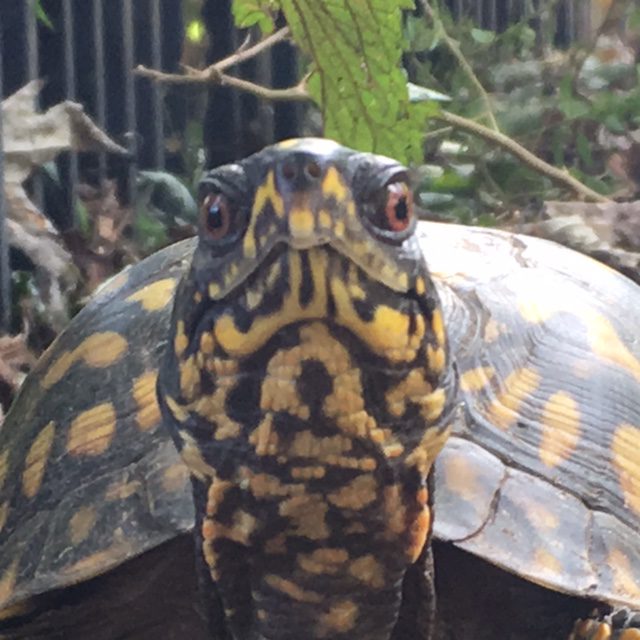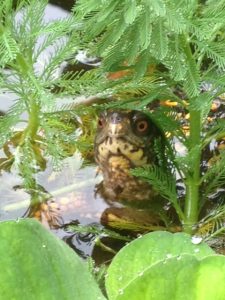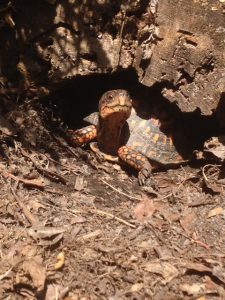The Smallest Dinosaur
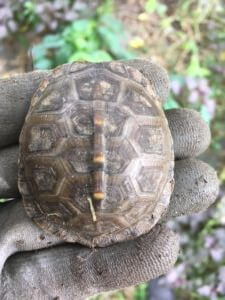
A 2 year old baby eastern box turtle.
Finding a baby turtle is indeed a rare and exciting event.
Hatching out of an egg that was buried 6 inches below, months before and digging its way to the surface, only to to spend the first few years of life hiding below leaf litter and mulch, eating worms and bugs that happen by, and counting on moisture from rain, does indeed sound like a struggle from another, perhaps prehistoric time.
In fact, Turtles are nothing more then dinosaurs. Their fossil history indicates that they did once roam the earth along side dinosaurs more then 200 million years ago.
How is it then that turtles survived catastrophes that wiped out most of the inhabitants of our earth?
Super Powers
Turtles, it seems, have an abundance of super powers. Whether they live in a body of water, in an arid desert, or in our wooded hillsides, Turtles have developed some amazing abilities to overcome adversity and adapt to their micro-habitat.
Mother box turtles can lay 2 or even 3 nests of 2-6 eggs a summer, often digging a “false nest or two” to throw off egg thieves. An Adult Eastern Box Turtle is relatively safe from most natural predators in its native habitat. Its defense mechanism, of tightly closing up its shell, to form a tight “box”, not only gave the Box Turtle its name, but has served it well for millions of years.
Baby Eastern Box Turtles do not hatch with the natural defense of an adult, and rely on their ability to stay hidden and to blend into their environment and, although it is believed that only one in a thousand baby turtles ever reach reproductive age, they are well equipped to survive with a minimum of sustenance for their first year of life in the wild. Often, if a clutch is laid late in the summer, and the above ground temperature is changing toward the cooler days of autumn, Baby box turtles will stay in their nest through out their first winter, and make an early appearance with the spring rains.
The Mother turtle prepares a nest by digging a hole with her back legs as deep as she can, clearing out a cavity in firm earth, located above flood level,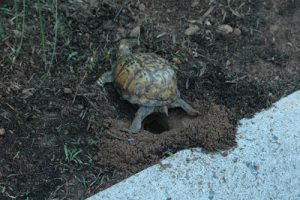 this allows the nest temperatures to remain stable and the cavity gives the babies room to dig out. The Mother turtle will carefully bury her eggs and with unbelievable skill, will place a final layer of leaves or mulch on top, which will make the nest almost indiscernible to the average eye, once completed, the mother turtle abandons the nest. The eggs, and hatchlings are left on their own.
this allows the nest temperatures to remain stable and the cavity gives the babies room to dig out. The Mother turtle will carefully bury her eggs and with unbelievable skill, will place a final layer of leaves or mulch on top, which will make the nest almost indiscernible to the average eye, once completed, the mother turtle abandons the nest. The eggs, and hatchlings are left on their own.
The temperature of the nest, will determine the length of incubation, usually 60-70 days, and will determine the sex of the hatchlings. With a process called Temperature- Dependent sex determination, gender is determined. With an ideal temperature of between 72°F – 93°F, embryos in the lower temperatures will be males and in the higher temperatures will be females. Those in the middle could be males or females. Like a bird, baby turtles are equipped with an egg tooth, a hard sharp protuberance at the tip of their beak, that they use to break through their egg shell. Hatching can take a few hours or a few days. Often, after hatching, the remnants of their yolk sac is still visible, and can support them for several weeks.
These tiny dinosaurs are at the most vulnerable stage of their life. Hatched in an earthy brown color, to help keep them hidden, they will spend the majority of their time hiding and waiting for bugs and worms to cross their path. At hatching, their little shells are pliable and their hinge will not be fully functional until they are 4-5 years old. If lucky, they will continue to grow for about 15-20 years, and develop patterns and colors on their shells that are uniquely theirs.
How Can You Help Baby Box Turtles?
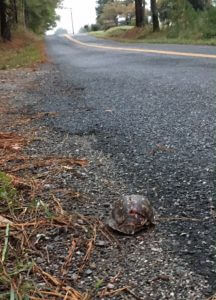 The loss of natural and native habitat is causing turtles to appear in some unlikely places. Mother turtles of all kinds may walk far from their home to find the perfect site to dig their nest, often crossing roads and lawns on their journey. Many times, due to man-made altercations to the landscape, baby turtles appear where one least expects them, and unfortunately, there is not always a suitable habitat nearby that could sustain a viable population.
The loss of natural and native habitat is causing turtles to appear in some unlikely places. Mother turtles of all kinds may walk far from their home to find the perfect site to dig their nest, often crossing roads and lawns on their journey. Many times, due to man-made altercations to the landscape, baby turtles appear where one least expects them, and unfortunately, there is not always a suitable habitat nearby that could sustain a viable population.
Box Turtles are known to inhabit a “Home Territory”, this is usually built around their hatching place, and as the turtle grows and explores his habitat, favorite places for food, water, and hides are stored in memory. Like a compass, the turtle can find the exact location of this home, and if he is removed from it, or if it is destroyed, he may wander endlessly looking for it, surviving solely on luck.
It is believed that this homing ability develops over the life of the turtle, the older the turtle, the more likely he is to search for home. Where as baby box turtles are able to be relocated and released in suitable habitat.
Baby turtles are truly amazing. They are great to share with your kids and to take some photos with, but it is important that we let these turtles remain in the wild, or they will soon be extinct in native habitat that they called home for millions of years. As reptiles, Turtles are connected to our earth in a way that as mammals, we can only imagine. Their connection is weather related and the cycles of our Earth, our Sun and our Moon have created a pattern over the eons that turtles have become programmed with. To keep a turtle in captivity means we must duplicate a natural environment to the best of our ability, and to keep a baby turtle as a pet is indeed an daunting task, as he may well live more than 100 years.
Baby Box Turtles needs are simple, but specific. Although Omnivores as adults, Baby box turtles need protein and calcium for their shells to grow strong, and start out their life journey as strict carnivores. Living among the leaf litter on the forest floor, they wait for food to come their way, eating pill bugs, worms and beetles.
If you have found a baby box turtle and are looking for the best option for release Please consider the following: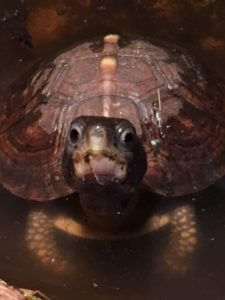
- As an adult your baby will need 2-10 acres of undisturbed habitat
- with native plants and natural clean water.
- A natural forest floor with leaves and rotting logs.
- it is always best to place a moved turtle near a water source and a natural hide (downed tree etc)
- If in doubt, contact a local wildlife rehabilitator , or a wildlife veterinarian that can give you names of qualified people that can help.
Turtles are Unique and Amazing!
We are fortunate to be living among them, in their world.
Sadly, if we do not become more considerate of our actions when we destroy habitat and pollute our earth, it is likely that they will disappear in the wild within a generation or two.
The Eastern Box Turtle is one of the most unique and beautiful turtles in the world. Each one different, with patterns and colors, and as unique as you and me. Thank you for learning more about our shelled friends and please help us protect them for future generations! Educate, Donate and Volunteer.
Please share!
I would love to hear your feedback.
